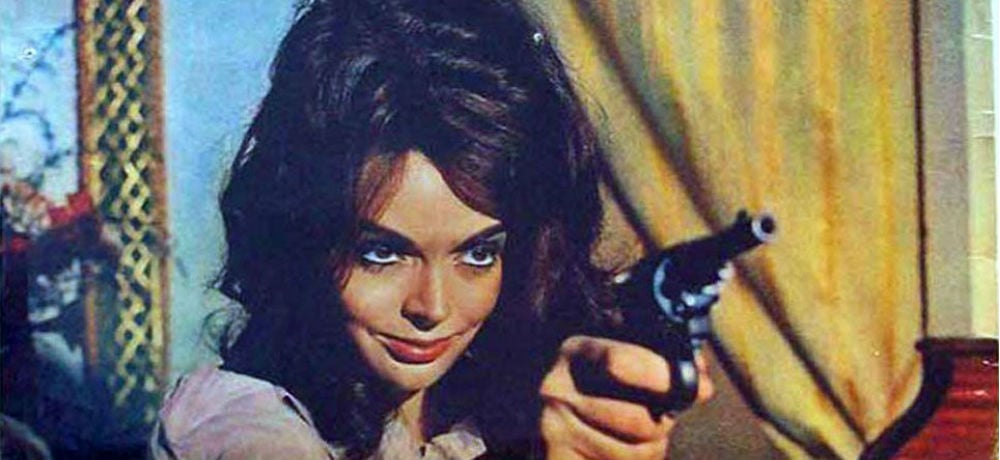


Barbara Steele is a horror mainstay who, like Vincent Price and Christopher Lee, found a place in the genre during the gothic heyday of the 1960s and made a comfortable home there for years. Also like Price, Steele has a look that, when the time calls for it, she can manipulate to ooze sinister intentions. Somehow she can turn just a little extra cock of her eyebrow into a visage that makes the audience squirm, and she’s employed this knack for the malevolent over the course of several decades in films like Black Sunday, Piranha, and Shivers (to be fair, in that last one it’s not so much her character that’s evil as the mutated STD slug that’s taken over her body). So when I went diving into Steele’s filmography, I wanted to find something that tapped into that evil streak, and I found it tucked in a little Italian gothic noir film from 1963 called The Ghost.
The original Italian title was Lo Spettro, which is such a cooler name. I know spettro is just Italian for “ghost” (or “specter” if we’re being literal), but Italian is funny that way in that it gives a slicker sheen to words that seem fairly mundane in English. Take cannoli, for instance. Pretty fancy name for a dessert right? It is, until you realize it’s just Italian for “little tube.” Oddly enough, when they released the film they seem to have felt compelled to remove a large portion of the Italian flair from the credits, as many of the names were Anglicized for marketing materials. Director Riccardo Freda, one of the grandfathers of giallo films, was credited as “Robert Hampton,” and much of the other Italian crew were given similar aliases.
There doesn’t seem to be any reason given for this, so I can only assume it was to give credence to the notion that the film takes place in early 1900s Scotland, which in no way looks like it was shot in 1960s Rome and is given a real layer of authenticity by having all of these Scottish characters dubbed with upper-class English accents. The story picks up with John Hichcock (Elio Jotta), a wealthy doctor with a proclivity for séances and experimental medicine. The séances don’t seem to amount to much other than a setup for what will come later, but the experimental medicine is something in which he has a vested interest, as he and his assistant Charles Livingstone (Peter Baldwin) are attempting to cure Hichcock’s longtime physical disability through a controlled regimen of small doses of an exotic poison followed immediately by the antidote. Now, one might question the logic of using poison to cure a disability, but given that Bayer used to sell over-the-counter heroin as a cough suppressant in the late 1800s, it’s not such a far-fetched concept.
And Hichcock is clearly desperate, as years confined to a wheelchair have left him depressed and suicidal. And of course, as one does in films like this, Hichcock’s wife, Margaret (Steele), has developed a healthy coping mechanism for her strained relationship with Hichcock: she’s having an affair with Charles!. And to be clear, this isn’t one of those nuanced stories where two damaged people find comfort in one another while trying to reconcile the moral ramifications of what they’re doing. Nah, Margaret and Charles are simply awful people who just hate Hichcock for being too much of a sad sack.
So Margaret convinces Charles to murder her husband by forgoing the antidote portion of his poison treatment, allowing them to live blissfully on his inheritance, including the house and a third of his fortune (alas, the other two-thirds are being bequeathed to those rotten children at the orphanage—the nerve!). Unfortunately for them, this victory is short-lived, as odd occurrences begin happening around the house. Hichcock’s wheelchair tumbles down the stairs all by itself. Margaret sees his ghostly image threatening her from the shadows. He even takes time to possess the housekeeper, Catherine (Harriet Medin), to send Margaret and Charles cryptic messages. But worst of all (for Margaret and Charles, anyway) Hichcock appears to be barring them from the money from beyond the grave, hiding the key to his safe and keeping their happily ever after just out of reach.
So it’s here that I feel the need to give a spoiler alert, but odds are if you’re keeping up, then this won’t come as a huge surprise: Hichcock’s not dead, but rather faked his death because he knew that Margaret and Charles were having an affair and wanted to exact his revenge. Having guessed this early on in the film, it shifted how I watched it because rather than seeing it for scares, I was more just enjoying watching Hichcock screw with his would-be killers in something of a gothic, psychological version of Home Alone.
Both Steele and Baldwin play up the awfulness of their characters to make the process that much more satisfying. Steele, in particular, isn’t so much evil as she is just kind of a pill. She’s always bemoaning the terrible things happening to her, like being saddled with a “crippled” husband or having to share her inheritance with those “rotten crippled children” (she really doesn’t seem to like people with disabilities). And Baldwin plays Charles as something of a spineless weasel willing to kill for Margaret, but also slapping her around a bit once things start going south.
In the end, The Ghost isn’t as much about the creep factor as it is the thrill of seeing awful people get their comeuppance. And, in true Italian horror fashion, we find out there really may not be any heroes to be found in the film and that everyone will be given their just desserts. Ultimately, The Ghost doesn’t tread any new ground, as the French film Les Diaboliques had explored similar themes eight years prior. But if you enjoy watching bad things happen to bad people, then The Ghost will certainly scratch that itch.